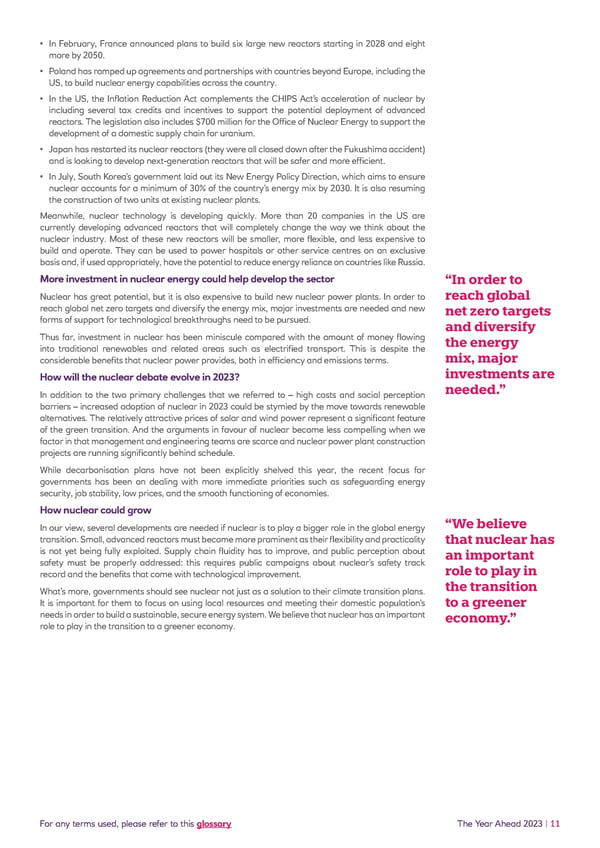• In February, France announced plans to build six large new reactors starting in 2028 and eight more by 2050. • Poland has ramped up agreements and partnerships with countries beyond Europe, including the US, to build nuclear energy capabilities across the country. • In the US, the Inflation Reduction Act complements the CHIPS Act’s acceleration of nuclear by including several tax credits and incentives to support the potential deployment of advanced reactors. The legislation also includes $700 million for the Office of Nuclear Energy to support the development of a domestic supply chain for uranium. • Japan has restarted its nuclear reactors (they were all closed down after the Fukushima accident) and is looking to develop next-generation reactors that will be safer and more efficient. • In July, South Korea’s government laid out its New Energy Policy Direction, which aims to ensure nuclear accounts for a minimum of 30% of the country’s energy mix by 2030. It is also resuming the construction of two units at existing nuclear plants. Meanwhile, nuclear technology is developing quickly. More than 20 companies in the US are currently developing advanced reactors that will completely change the way we think about the nuclear industry. Most of these new reactors will be smaller, more flexible, and less expensive to build and operate. They can be used to power hospitals or other service centres on an exclusive basis and, if used appropriately, have the potential to reduce energy reliance on countries like Russia. More investment in nuclear energy could help develop the sector “In order to Nuclear has great potential, but it is also expensive to build new nuclear power plants. In order to reach global reach global net zero targets and diversify the energy mix, major investments are needed and new net zero targets forms of support for technological breakthroughs need to be pursued. and diversify Thus far, investment in nuclear has been miniscule compared with the amount of money flowing the energy into traditional renewables and related areas such as electrified transport. This is despite the mix, major considerable benefits that nuclear power provides, both in efficiency and emissions terms. How will the nuclear debate evolve in 2023? investments are In addition to the two primary challenges that we referred to – high costs and social perception needed.” barriers – increased adoption of nuclear in 2023 could be stymied by the move towards renewable alternatives. The relatively attractive prices of solar and wind power represent a significant feature of the green transition. And the arguments in favour of nuclear become less compelling when we factor in that management and engineering teams are scarce and nuclear power plant construction projects are running significantly behind schedule. While decarbonisation plans have not been explicitly shelved this year, the recent focus for governments has been on dealing with more immediate priorities such as safeguarding energy security, job stability, low prices, and the smooth functioning of economies. How nuclear could grow In our view, several developments are needed if nuclear is to play a bigger role in the global energy “We believe transition. Small, advanced reactors must become more prominent as their flexibility and practicality that nuclear has is not yet being fully exploited. Supply chain fluidity has to improve, and public perception about an important safety must be properly addressed: this requires public campaigns about nuclear’s safety track role to play in record and the benefits that come with technological improvement. What’s more, governments should see nuclear not just as a solution to their climate transition plans. the transition It is important for them to focus on using local resources and meeting their domestic population’s to a greener needs in order to build a sustainable, secure energy system. We believe that nuclear has an important economy.” role to play in the transition to a greener economy. For any terms used, please refer to this glossary The Year Ahead 2023 | 11
 NatWest Year Ahead 2023 Page 10 Page 12
NatWest Year Ahead 2023 Page 10 Page 12